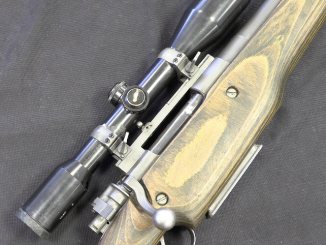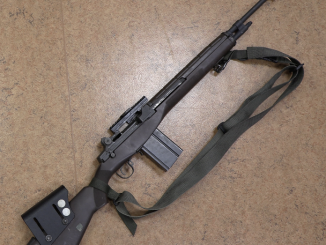In the early 1930s, the Estonian military and Estonia Defense League had a rather eclectic mix of small arms. The Army had three divisions, and split different types of weapons between them to simplify logistics. Thus, there was one division equipped with rifles and machine guns in 7.62x54R, and another with .303 British. For sniper/marksman rifles, the Army was heavily influenced by the civilian shooting community (which was also heavily represented in the Defense League). Estonian teams were very successful in international competition in the 1930s, and they used military-caliber rifles with sporterized stocks, diopter sights, and very heave barrels. And so that is what the Army and Defense League adopted, with the Tallinn Arsenal producing new barrels and sights and assembling the rifles.
Specifically today, we have a P14 Enfield that has been converted to 7.62x54R, and a Type 38 Arisaka converted to .303 British. Both have 24mm in diameter barrels (adopted after the initial batch of 27mm barrels proved really a bit too heavy), Tallinn-made sights, and pistol grips spliced into their stocks. Not much data exists about these rifles, but we do know that their production ran from 1931 until World War Two, and in 1939 the total number in military inventory (combined between the army, Defense League, and Border Guards) was 1,170. Today they are extremely rare – these are the only two examples I have seen, and they were both discovered hidden in homes that were being renovated.
Many thanks to the Estonian War Museum for allowing me to take this one out of their display to film for you. If you find yourself in Tallinn, definitely take time to stop by and check them out! Hours and rotating exhibits are available on their web site: https://esm.ee




In terms of the action, a conversion from 0.303in (7.7 x 56mmR) to 7.62 x 54mmR wouldn’t be much of a problem, as both are rimmed cartridges, although 0.303in’s rim is larger in diameter (.530in vs .445in).
Converting 7.7 x 58mm Arisaka to 7.7 x 56mmR seems a strange way of dong things, though. Wouldn’t it have been simple to just issue the unaltered 0.303in P14s to the units with MGs in that caliber?
clear ether
eon
“(…)Converting 7.7 x 58mm Arisaka to 7.7 x 56mmR(…)”
Now I am extremely confusing, as I always though Type 38 Arisaka is 6,5 mm weapon. Can you provide reliable source claiming that Estonian did use 7,7 mm Arisaka rifles as base for their conversion?
Oops, you’re right. I should have noticed that.
But the point remains. WTH convert 6.5 x 50mm rifles to 0.303in when you already have Pattern 14 rifles in 0.303in, and then turn right ’round and convert those P14’s to 7.62 x 53mmR?
It. Makes. No. Sense.
But then, most military procurement, in any country, seems to fall into that category.
Incidentally, converting 6.5 x 50mmSR Arisaka to 7.62 x 51mm NATO (aka .308 Winchester) is dead easy. the Arisaka chamber is just enough smaller than the .308 that once you’ve rebored and rifled the bore, a .308 chambering reamer cleans it up to exact specifications. The rims of the 6.5 round and the .308 round are essentially identical (.471 in vs. .470 in).
cheers
eon
C.I.P. maximal pressures (MPa) for cartridges are as follows
6,5 mm Japanese 295
7,7 mm British 365
7,62 mm Russian 390
thus I presume they might fear latest might be too much for Arisaka action designed for first of them. On the other han Pattern 14 rifle was remake of weapon designed for .276 Enfield cartridge running at higher pressure than 7,7 mm British and thus in effect also higher than 6,5 mm Japanese.
Do not underestimate the 6.5 mm Arisaka. Julian S. Hatcher reports about U.S. trials how military rifles react to overpressures. He writes “the action of this rifle is harder to wreck than those of the Springfield, Enfield [M1917], or Mauser” [Hatcher’s Notebook, 3rd edition,p. 206]
“(…) 6.5 mm Arisaka. Julian S. Hatcher reports about U.S. trials how military rifles react to overpressures.(…)”
Thanks for information. I was aware about practical test showing that, but though it was done by P.O.Ackley.
Many moons ago, I came across a couple pieces of very interesting brass on a popular piece of public land: 7.62x54R, but with the distinctive round .303 shoulder apparently fire-formed in. No conversion necessary, for that guy.
“Weird brass found on public land…” is a thing you just have to wonder about, when you consider just how much “weird” might be being overlooked because the average person isn’t informed enough to recognize what’s weird and what isn’t.
Circa 1986-87, I was passed a little baggie of “weird” in the form of 5.45X39 cases that were supposed to have been found on a beach in an Alaskan inlet.
No big deal, these days, but… That was the era in which Soldier of Fortune was paying big money for 5.45X39 and working AK74 rifles in Afghanistan, and the folks at the Army’s technical intelligence units hadn’t yet gotten their hands on any.
I’ve never gotten a good explanation for how that could have happened, short of “Well, something Soviet and hinky was going on along Alaskan shores…”
And, the reason why I brought it up? The guy who’d found it had no idea what the hell it was or what it represented… All he knew was that it was not 5.56X45 like he’d been issued in Vietnam, and that the headstamps looked funny, plus the material of the case wasn’t “right”. If he hadn’t have recognized those cases as being out of the ordinary, he’d have left them lying there to get washed out to sea, or whatever else might have happened to them.
Makes you wonder how much other “weird” might be out there, because the people who found it didn’t recognize it for being what it was, out of place or out of the ordinary.
I remember hearing once the the Russians ran some listening posts on those tiny islands close to Alaska, so possibly practice brass from the guys on guard duty there floating over? I would figure that the guys guarding that kind of installation would be GRU or maybe KGB troops and therefore higher on the rifle food chain, hence 5.45
The inlet and beach that these cases were found on was reported to me as “…along the coast southwest of Seward…”
The whole thing makes no sense; if someone had handed me those cases any year after about 1994, I’d have been totally nonplussed about it. The year that it happened, however? I’d just read some of the writeups about the AK74 and its cartridge in the literature, and hadn’t seen anything “in the flesh”. The guys at the technical intelligence detachment working with 1st SF Group hadn’t seen anything, either. Having some old guy, who was the uncle of one of my troops, show up and hand me a baggie full of that brass (well, steel, I think…) was a bit of a “WTF?” moment.
I’ve got two explanations for it: Either there was someone from the Soviet side playing games on Alaskan turf, or it was our guys playing with Soviet weapons they’d acquired, somehow. The distance from any military bases militates against it, although I suppose that it’s possible. Someone once told me that that area of Alaska had been popular at one point for the SEAL teams to do training in.
Other than that, I’ve got nothing. The whole story was that this guy’s uncle, who handed me the brass, had been out with his fishing boat one morning, heard what he thought was automatic fire from something, and he’d gone to check it out, which was when he’d found the cases. Once I told him what they were, he clammed up and didn’t want to talk about it any more.
It’s one of those things that you experience and then spend the rest of your life going “WTF was that all about, anyway…?”
“…discovered hidden in homes that were being renovated.” Doubtless, the Eastern European equivalent of a “tragic boating accident”
Those are some pretty Parker – Hale looking sights.
Odd that the stock the Arisaka is in shows the typical drill holes seen on the stocks of Ross Mk.III rifles reportedly converted to Drill Purpose in India after WWI. IIRC the War Office bought about 60,000 Arisakas in WWI, so interesting to ponder how such a stock would end up in Estonia, or did the Estonians buy the DP’d Arisakas from the British and then rebarrel them?
It would have been interesting to know how the backsight was attached on the P.14 and if it was as much of a copy of of the A.J. Parker and Parker Hale types as it looks to be. Rusty condition suggests both rifles were hidden away during the Soviet occupations